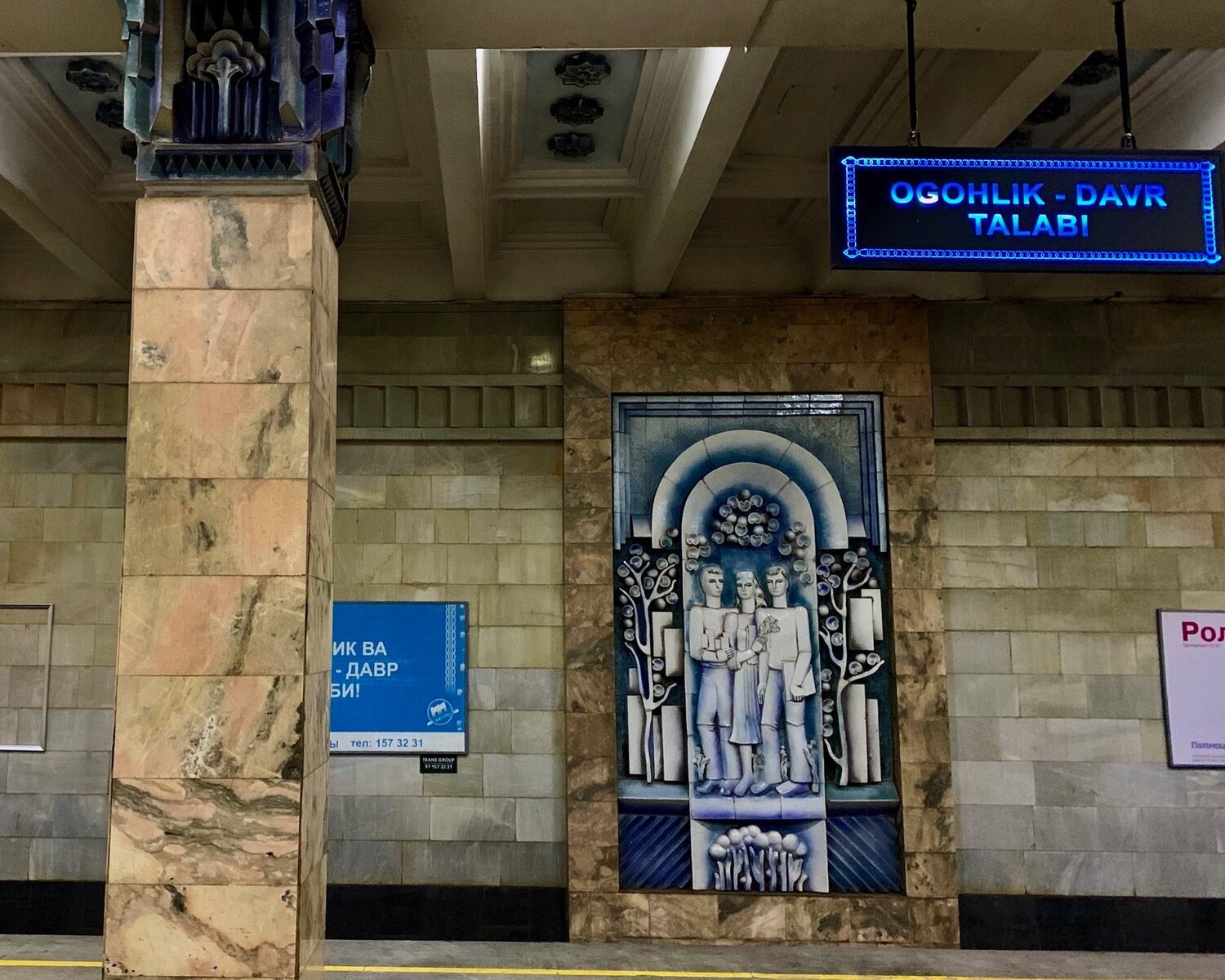Toshkent Station train (all photos by the author for Hyperallergic)
TASHKENT, Uzbekistan — Tourists in most large cities across the world will pay a tidy sum of money to see some of the greatest artworks in national museums and private galleries. Yet, studied commuters of each of those metropolises have a secret among them: many wonderful creations reside in the metro stations. For the price of a ride from point A to B, New Yorkers can see William Wegmans and Roy Lichtensteins; Parisians can peruse the sinuous tropical flowers gates designed by famed architect Hector Guimard; and London tube riders can view such works as “Pleasure’s Inaccuracies” by Scottish artist Lucy McKenzie.
Although the Metro of Moscow receives heaps of attention, the Toshkent Metropoliteni (or the Tashkent Metro) of Uzbekistan’s capital certainly deserves some due. Begun in 1972, six years after a major earthquake devastated the region, Soviet engineers and crews with pickaxes finished its first line — the second subway constructed in Central Asia — in 1977, with nine stations. Many pay tribute to the history of Uzbekistan, including its infamous cotton production, the first man and woman in space, and the city’s mosques and madrassas. Some Soviet throwbacks have been renamed, including the October Revolution Station, which is now dedicated to Amir Timur (Tamerlane), a 14th-century Central Asian military leader, as well as Maxim Gorky Station — now, the Great Silk Road Station.
Kosmonavtlar Station
Under the dictatorship of Islam Karimov, whose 27-year reign ended with his death in 2016, the subway was used as a nuclear bomb shelter. Taking photographs inside Tashkent’s subway stations was therefore prohibited, with lingering guards at the ready to snatch cameras. But the current president, Shavkat M. Mirziyoyev, lifted the ban in 2018. Now, for the equivalent of 15 cents, shutterbugs can explore about 43 stations along 37 miles of track with more opening every other month.
For a quick tour, below are some of the most stunning stations:
Olmazor Station: This station is dedicated to Red Army Major General Sabir Rakhimov, a Soviet war hero who broke through German lines in World War II and died from his wounds. Upon entering Omazor, walk under a large wooden bas-relief of a Soviet army helmet and gun at one end and a hammer and sickle at the other. Between them are a dozen or so red marble engravings of fighting and marching soldiers, as well as the mourning mothers of soldiers — all of whom lost their lives in the various wars fought by the USSR.
Olmazor Station
Chilonzor Station: Chilonzor’s dozens of ceramic murals depict scenes of traditional Uzbek life, from farmers in the field to men raising glasses of chai tea atop a tapchan, a covered outdoor couch. Along the concave ceiling are chandeliers of golden crowns and crystal lights reminiscent of a large hotel ballroom. Sharov Rashidov, the First Secretary of Uzbekistan’s Communist Party, made 18 trips to Moscow to gain the necessary permissions for the Tashkent Metro, and made sure that Metrogiprotens, the Soviet oversight agency, literally cemented the cultural legacy of the Uzbeks.
Chilonzor Station
Alisher Navoi: Renowned sculptor Ahmet Shaymuradov spent four years creating the turquoise blue bas-reliefs that depict scenes from Khamsa — five epic, Turkic poems by Ali-Shir Nava’i, a 15th-century Uzbek “Renaissance Man” (poet, writer, politician, linguist, mystic, and painter). The station’s intricate domes resemble the mosques and madrassas built during the height of Uzbekistan’s Silk Road era.
Alisher Navoi Station
O’zbekiston Station
Toshkent Station
Toshkent Station: Toshkent Station receives mixed reviews on its beauty, but high marks on its spectacle. Each entrance prominently displays an emblem of the city’s 2,200 years of history, including a mosaic of the national coat of arms: a Huma bird with outstretched wings surrounded by cotton and wheat, the country’s two main crops. The remainder of the station displays Greek-revival sculptures of daily Uzbek life. O’zbekiston, a sister station, uses ornate glass-and-steel street lamps in the shape of cotton balls to pay tribute to the Soviet’s main export.
Gafur Gulom Station
Kosmonavtlar Station: Largely regarded as the most beautiful of Tashket’s stations, Kosmonavtlar’s brightly colored walls fade from blue to black, supposedly to “recreate all the stages of exploring space,” according to its designer, architect Sergo Sutyagin. Along those walls, blue ceramic medallions feature some of the pioneers of the Soviet space program, including Yuri Gagarin, the world’s first cosmonaut, and Valentina Tereshkova, the first woman in space. For the final touch, artisans painted the ceiling to look like the Milky Way.
In September 2016, the Tashkent Metro Authority announced the construction of Sirg’ali yo’li (Yellow Line) a southern expansion that will be connected to all of the other metro stations with the ring-shaped Halqa yo’li (Circle Line). Sutyagin, for one, has said that he still rides the original lines daily. “Every time I see tourists taking pictures … I say to myself, ‘What a good job I did! What a good job we all did!’”
Buyuk Ipak Yuli Station
Tinchlik Station




















